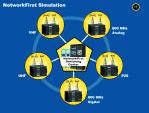Interoperability: Communicating in a Crisis
 |
 |
 |
 |
 |
The events of September 11, 2001, brought to light the woeful inadequacies of the emergency communication systems in the United States. With the threat of new terrorist acts a reality, it is critical for first responders to be coordinated and informed. Reliable, interoperable communications will greatly enhance the safety of our police, fire, emergency medical workers, and citizens.
“Public safety officials have always regarded reliability and security as imperative attributes for their emer gency communications tools,” says Thomas Von Essen, retired Commissioner of the New York City Fire Department. “But now, due to the necessity of collaboration between agencies and jurisdictions, interoperability has become vitally important.”
Nothing illustrates the importance of crisis communications better than the initial response efforts to the terrorist attacks in New York and Washington, DC.
“While emergency workers from 10 separate jurisdictions responded within 10 minutes after the airliner hit the Pentagon, their efforts were stymied due to the inability to link the different radio frequencies,” says Dale Craig, First Responder Program Director for Raytheon. “Effective command of any incident involves being able to manage real-time information among the mutual-aid teams that respond from different jurisdictions and agencies.”
Fortunately, solutions to first responders’ age-old communications problems are fast entering the marketplace. Whether in the form of fiber-optic, Internet, intranet, or satellite network, municipal, state, and federal entities are working to meet the demands of reliable communication systems for emergency and government personnel.
Emergency communications encompasses a much broader range of technologies than in the past. Today, entities are building mobile computer networks, providing nationwide database connectivity, and implementing interoperable systems for seamless two-way radio operation over multiple frequency bands and disparate communication systems.
District of Columbia
The Washington, DC, Department of Public Health has begun work on the city’s electronic disease surveillance and counter bioterrorism system.
The new system will conform to standards promoted by the Centers for Disease Control (CDC) and is designed to shield the Washington, DC, area from potential disease outbreaks and unconventional bioterrorist attacks.
The CDC’s National Electronic Disease Surveillance System (NEDSS) is an initiative that promotes the use of data and information system standards to advance the development of efficient, integrated, and interoperable surveillance systems at federal, state, and local levels.
The solution allows the Department of Health to combine public health information from a variety of public agencies, analyze this data to identify potential threats, and alert appropriate personnel for follow-up investigations. Using wireless and GIS functionality, data can be viewed remotely and geographically, providing a detailed and accurate picture of a possible outbreak.
The Department of Health contract brings together Accela, Inc., Atlantic Management Center, Inc. (AMCI), and Oracl e Cor poration. AMCI will work with both Accela and Oracle to integr at e and impl ement Accela’s Bi o-Alert and Oracle’s Health Data Integration Hub (iHub) and Healthcare Transaction Base (HTB). The solution will connect various surveillance sites and health information systems into one centralized database, the HTB. From there, AMCI will link this information to the Bio-Alert and iHub user interfaces and al low t he Depar tment of Publ ic Health to analyze data and customize reports to fit their specific needs.
Phase I of the NEDSS implementation is scheduled to be operational in September 2003.
Concern for safety in the Washington metropolitan area has generated a need not only for bioterrorism protection, but also for improved coordination and information sharing between public safety and transportation agencies in Maryland, Virginia, and the District of Columbia. With the development of interagency partnerships, these groups serving the Capital Belt-way and surrounding Washington-area road network combine limited resources and work toward the common goal of improving safety.
The result of this cooperative effort is CapWIN, the first multistate, inter-jurisdictional transportation and public safety integrated, wireless network in the United States.
The primary goal of the CapWIN project is to allow multiple mobile data platforms to communicate seam-lessly across the network regardless of their jurisdiction or geographical location. CapWIN end users will include federal, state and local police, fire, and EMS vehicles as well as state DOT service patrols.
In the near future, interagency personnel will communicate via laptops and Per sonal Digital Assist ants (PDAs). The devices will allow individuals and agencies to coordinate efforts and create cross-jurisdictional response teams. For example, a police officer responding to an event will be able to communicate simultaneously with firefighters, ambulance drivers, transportation response units, as well as hazardous materials teams and other special units. “As we set up CapWIN, we are trying to develop a national model,” says John Binks, CapWIN Training Manager.
The vendor-neutral project has been developed with an open architecture so that other government entities can identify the coding behind the scenes. The use of commercial, off-the-shelf software allows the system to be recreated across the country.
“Our initial area of concentration is the Greater Metropolitan Washington region (DC, Upper Virginia, and Lower Maryland),” says Binks. “A great deal of interest has been well received throughout the nation.”
Ex-fire chiefs, ex-police department commanders, and officials from the federal level of transportation departments make up the majority of Cap-WIN personnel. Retired from law enforcement, Binks taught police officers to use mobile laptop computers in police vehicles. “We have other individuals that were involved with different aspects of either their agency or their state with developing computer systems for their fire or police agencies or the transportation realm,” says Binks.
“The thing that has really made CapWIN work is the fact that we are a group of people that have been there,” says Binks.
As a grant-funded, nonprofit project, CapWIN coordinators are able to offer the project to interested agencies at no cost. CapWIN, which is based out of the University of Maryland, provides interested agencies with a few free laptop computers and begins Beta testing. According to Binks, “All an agency has to do is provide connectivity through an Internet provider of their choice, hook up through our switching system, and it’s all free.
“We went the grant route and we’re giving it away,” he says.
The initial production-ready rollout of the CapWIN system will begin in September 2003. The CapWIN “Beta Release” will occur from September through November in advance of the final CapWIN system (Version I) deployment in December 2003. Mobile users representing law enforcement, fire and rescue, and transportation services from select areas in Maryland, Virginia, and the District of Columbia will be connected via the Cap-WIN wireless gateway.
The Beta Release will include: 1) incident management capability across all first responder disciplines; 2) instant messaging capability for all participants; and 3) select local and national law enforcement database queries for police officers.
The browser-based Cap-WIN Beta Releas e system will be accessible to users with existi ng mobile data platforms as well as new mobile installations. CapWIN ultimately will provide a communication network for 10,000 first responders from 35 local, state, and federal agencies.
Commonwealth of Kentucky
A statewide committee on communications interoperability with a focus on wireless solutions has been established by legislative law in Kentucky. The newly-formed Wireless Committee is made up of emergency-management, communications, homeland-security, state, fire, and public-works representatives from state, county, and local government as well as private-sector technical advisors.
“What we’re trying to do is standardize not only equipment, but protocols,” says Colonel Ray A. Nelson, Executive Director, Office for Security Coordination, Kentucky Homeland Security. “It’s going to cost a lot of money to do this, and we want to do it right the first time.”
While evaluating wireless communications vendors, six Kentucky public safety agencies participated in a statewide interoperability demonstration using Internet-based technology. The system enables different public safety agencies such as state and local police, fire, EMS, and federal with disparate communications systems to communicate.
With more than 200 Kentucky first responders viewing the demonstration, members of the Kentucky National Guard, State Police, and Frankfort, KY, Fire Department spoke, for the first time, using disparate brands of two-way radios while communicating over multiple-frequency bands.
According to Nelson, the demonstration showed a capability that was a first in Kentucky. “It was a great step in the right direction,” says Nelson.
With a communications ring that stretched more than 360 miles from the eastern County of Pike to the western County of Muhlenberg, NetworkFirst, manufactured by M/A-COM, highlighted the inherent advantages of implementing an interoperable communications system based on Internet Protocols.
“This is truly a technological and political milestone for Kentucky,” says Bob Stephens, Branch Manager for Kentucky Emergency Management. “We [Kentucky Emergency Management] have never spoken with the Kent ucky State Police through our radios or from a single remote location.
“The enhanced safety of implementing an interoperable system statewide is tremendous,” adds Stephens.
For the demonstration, the Network-First system was connected into the intranet operated by Kentucky’s State Police and National Guard units. M/ACOM and emergency officials from the Frankfort Fire Department, Frank-fort’s Emergency Operations Center (EOC), and the Greenville, KY, Range Control, a National Guard facility, were then able to communicate in groups or separately using different channels and frequencies.
“For one day, Kentucky’s emergency officials experienced true inter-operability,” says Craig Moore, NetworkFi rst product manager f or M/A-COM. “They used their own radios to connect to a single network and communicate with different public safety agencies around the region over a secure and permanent communications system.”
To communicate outside their organizations, these agencies currently use multiple radios or communicate through the same frequency band.
The state is evaluating short term efforts as well as long term. According to Nelson, “We’re trying to make sure that we have the right mix of near-term fixes versus long term strategic planning.”
Nelson expects a recommendation from the Wireless Committee within the year.
Mid-America Regional Council
The Mid-America Regional Council (MARC) serves as the association of city and county governments and the metropolitan planning organization for the bi-state Kansas City region.
Its volunteer efforts help build a stronger regional community through cooperation, leadership, and planning. MARC’s officials, area jurisdictions, and diverse community interests address the region’s problems and identify the opportunities for cooperative solutions.
Emergency services is just one of the many regional issues the council addresses. MARC coordinates a broad range of emergency services on behalf of public and private agencies throughout the metropolitan community. These efforts make the area better prepared to respond to hazardous waste spills, acts of domestic terrorism, and natural disasters.
A MARC Steering Committee is coordinating the development of the Metropolitan Emergency Information System (MEIS), which will allow local, state, and federal agencies and partner organizations unprecedented communications capabilities for emergency planning, response, and recovery through a secure, Webbased system.
The first phase of MEIS was completed in late 2002, with funding from the U.S. Public Health Service. The system allows emergency response agencies and partners a secure, online environment to develop and maintain response plans, access data during large-scale events to support mutual aid and regional coordination, and improve management of recovery efforts. Phase I included the initial system design, developed by Apex Innovations, and identification and design of first-priority functions, including:
- A secure, online database of emergency contacts for the region, including organizational data and personnel skills, training, and certification information,
- Storage, retrieval, and collaborative development of plans, training, and exercise materials—including three-dimensional images, drawings, maps, spreadsheets, and more—in an online Emergency Reference Library.
- Online management of emergency assets, facilities, and equipment that are available for mutual aid during large-scale events.
- Coordination of communications and tracking of all projects among the multiple committees involved i n emer gency prepar ednes s and response.
- Purchasing guidelines for emergency equipment, including evaluation criteria, bid documents, and detailed diagrams and specifications.
- Financial management tools that will allow fund managers to track reimbursement funds, filing deadlines, and funding applications for internal, private, and state and federal funds.
Phase II of the project will move the system into implementation, as key participants collect, enter, and manage data for first-priority functions; design second-priority functions; and develop a user fee system that will sustain and enhance the project over time.
During Phase II, MARC will cont inue to seek involvement from a broad range of agencies, including emergency management offices; fire, police, and sheriff’s departments; public health departments; hospitals; emergency medical services agencies; and state and federal agencies.
The Greater Kansas City Community Foundation recently announced its intention to make a grant of $250,000 toward implementation of the system.
Federal Initiatives
The Department of Commer ce Technology Administration (TA) has begun working more closely with the Department of Homeland Security (DHS) under an agreement signed by the two agencies.
The formal working relationship is with the DHS Science and Technology Directorate and the TA’s National Institute of Standards and Technology (NIST). NIST research includes programs for the detection of chemical, biological, and other explosive threats. NIST is also working to develop inter-operability standards for first responders and is doing work on cybersecurity, radiation measurements, and biometrics, among other initiatives.
NIST already has been engaged in providing technical expertise in several important national homeland security priorities. DHS can continue to rely on NIST to assist i ndustr y through standards and measurements in bringing new homeland security technologies into the marketplace.
Improvements
Developing and implementing new technologies to connect first responders, no matter what their radio frequency or mobile connectivit y, throughout our public safety agencies is becoming a national priority.
We can be assured that there will be no shortage of natural and man-made disasters in the future, and government entities, nonprofit organizations, and private companies are working together to improve rescue and recovery efforts.
These examples are but a few of the many initiatives already under way that help to coordinate rescue and emergency operations across county and state lines and between local and federal agencies.
|
PRO PATHWAYS Atlantic Management Center, Inc. (AMCI)—provides tools for improving business practices between the federal government and its industry partners. Visit: www.amciweb.com Apex Innovations—provides real time, automated information management systems. Visit: www.apexconnectpks.com CapWIN—Capital Wireless Integrated Network. Visit: www.capwin.org KYEmergency Management— http://kyem.dma.state.ky.us M/A-COM, Inc.—Wireless telecommunications systems. Visit: www. macom.com MARC—Mid-America Regional Council. Phone: 816-474-4240. Oracle Corp.—software for enterprise information management. Visit: www.oracle.com |


















